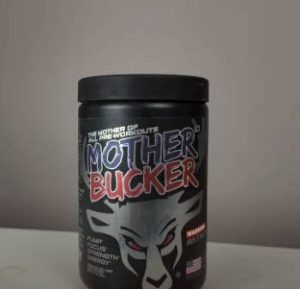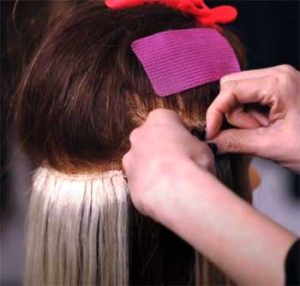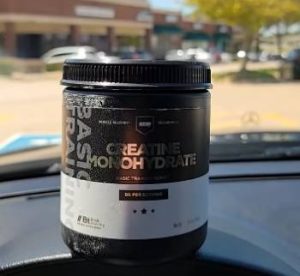Tired of period woes like irritation or leaks?
Honey Pot tampons transformed my cycle, and you should grab them too!
This review shares my journey, pros, cons, and tips for a healthier period.
With comparisons and real-user insights, you’ll see why these organic tampons are worth every penny!
My Experience with Honey Pot Tampons
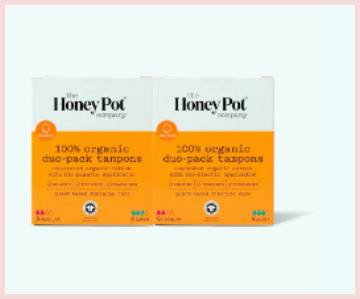
I’m a 35-year-old teacher in Chicago, navigating PCOS and heavy periods for years.
My cycles were brutal—cramps, fibroids, and leaks that ruined my favorite jeans.
I ditched tampons for pads seven years ago, fed up with irritation and that chemical-y smell.
But last spring, my birthday coincided with my period, and I refused to let it wreck my white dress plans.
A friend raved about Honey Pot’s organic tampons, so I ordered a box of regular and super absorbency ($9 for 18) via Amazon Prime.
The first day, I was skeptical.
The sugarcane bio-plastic applicator felt slick, but I found a trick: leave half the applicator out for a better grip on heavy days.
Insertion was smooth, and the organic cotton core felt gentle—no itchiness or weird vibes.
By hour four, no leaks, even on my heaviest flow, which usually demands a change every two hours.
I wore them confidently through a birthday dinner, no period panties needed.
My cramps were milder, and the usual pH-driven odor was gone.
Over five days, I used fewer tampons than with Tampax, saving a few bucks.
I’ve used Honey Pot for six cycles now, and my period’s less chaotic.
The hypoallergenic cotton seems to balance my pH, reducing irritation.
My PCOS symptoms—heavy flow and pain—feel more manageable.
The applicator takes practice, but the comfort and reliability are unmatched.
I’m hooked and hunting for bulk deals!
About The Honey Pot Company
Founded in 2012 by Bea Dixon, a Black woman inspired to heal her bacterial vaginosis naturally, The Honey Pot Co. offers plant-based period care.
Based in Atlanta, Georgia, the brand uses organic cotton and eco-friendly materials, donating 2% annually to support menstruating communities.
Their tampons are dermatologist- and gynecologist-approved, prioritizing vaginal health and sustainability.
Product Description
Honey Pot tampons are 100% organic cotton, free from pesticides, chlorine, fragrances, and dyes.
Available in regular and super absorbency (18-count, ~$9), they feature BPA-free sugarcane bio-plastic applicators and recyclable packaging.
Designed for hypoallergenic comfort, they expand evenly to prevent leaks, offering up to 4-6 hours of protection.
GOTS-certified cotton ensures no toxic residues, ideal for sensitive skin.
Maintenance Tips for Using Honey Pot Tampons
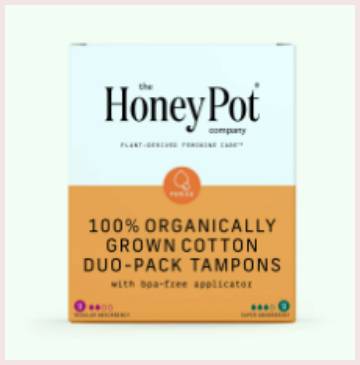
- Change Every 4-6 Hours
Swap tampons every 4-6 hours to prevent toxic shock syndrome (TSS).
I set phone reminders on heavy days to stay safe.
- Use the Right Absorbency
Pick regular for light flows, super for heavy.
I used super on days 1-2, regular later, avoiding over-absorption.
- Master the Applicator
Leave half the applicator out on heavy days for grip.
I practiced in the shower to nail the technique.
- Store Properly
Keep tampons in a cool, dry place.
I left a box in my humid bathroom, and the applicators warped slightly.
- Wash Hands Thoroughly
Clean hands before and after insertion.
I use unscented soap to avoid irritating my sensitive skin.
- Pair with Period Panties
Use period panties for extra protection.
I wear them on heavy days, saving outfits from leaks.
- Track Your Cycle
Log your flow to plan absorbency needs.
I use an app to predict heavy days, stocking super tampons.
- Dispose Responsibly
Wrap used tampons in tissue and bin them.
I avoid flushing to protect plumbing and the environment.
- Check for Irritation
Monitor for itchiness or discomfort.
I switched to Honey Pot after Tampax caused rashes, and it’s been smooth.
These tips keep Honey Pot tampons effective and safe.
Changing every 4-6 hours is non-negotiable—I’ve read TSS horror stories and don’t mess around.
Matching absorbency to flow prevents dryness; I wasted regular tampons on heavy days early on.
The applicator’s tricky, but my half-out trick makes insertion foolproof—practice helps.
Store them away from humidity; my bathroom blunder taught me that.
Hand-washing with unscented soap keeps my vagina happy, avoiding pH disruptions.
Period panties are a lifesaver on heavy days, sparing me laundry stress.
Tracking my cycle with an app lets me prep for super absorbency needs, avoiding surprises.
I bin tampons properly, knowing flushing harms pipes and oceans.
Checking for irritation ensures Honey Pot’s still right for me—my Tampax rashes are history.
Follow these, and you’ll love Honey Pot as much as I do.
Why Honey Pot Stands Out?
Honey Pot’s organic cotton and hypoallergenic design make periods healthier.
My PCOS symptoms eased, and irritation vanished.
The even expansion rivals Tampax for leak protection, and the eco-friendly packaging beats plastic-heavy brands.
Compared to Lola’s subscriptions or Cora’s cardboard, Honey Pot balances comfort and sustainability.
The brand’s mission—empowering menstruators—seals the deal.
Some Reviews Summarized
Users praise Honey Pot for reducing cramps, heavy flows, and irritation, especially for PCOS or BV-prone folks.
Absorbency shines on heavy days, lasting 4 hours, though the applicator’s slickness needs a workaround.
Compared to eight brands, Honey Pot’s durability and hygiene stand out, with fewer tampons needed per cycle, justifying the cost.
Pros of Honey Pot Tampons
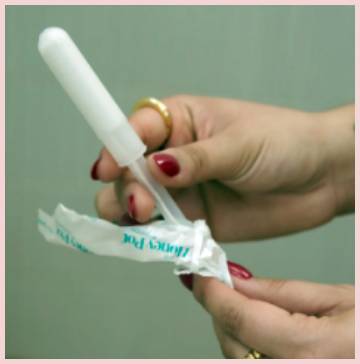
- Organic Cotton Core: 100% GOTS-certified cotton, no pesticides or synthetics. My sensitive skin loves the hypoallergenic feel.
- Reduced Irritation: No fragrances or dyes, balancing vaginal pH. I had zero itchiness, unlike with Tampax.
- Leak Protection: Expands evenly for heavy flows. I wore them 4 hours on day one without leaks.
- Eco-Friendly Design: Sugarcane applicators and recyclable packaging. You’ll feel good about less waste.
- Healthier Periods: Lessened my PCOS-driven cramps and flow. My cycles are less intense.
- Durable Absorbency: Fewer changes needed. I used half a box per cycle, saving money.
- Social Impact: 2% of profits support period equity. You’re helping communities with every purchase.
- Hypoallergenic Comfort: Gynecologist-approved for sensitive vaginas. My BV-prone body thrived.
- Sleek Packaging: Compact, discreet boxes. I toss them in my purse without worry.
Honey Pot tampons are a revelation.
The organic cotton core is a godsend for my sensitive skin—no more irritation or pH imbalances that triggered BV flare-ups.
Unlike conventional brands, these skip chlorine and fragrances, keeping my vagina happy.
On heavy days, the even expansion held up for 4 hours, sparing me the usual leaks that wrecked my outfits.
The sugarcane applicator, while tricky, is eco-friendly, and the recyclable packaging aligns with my green values.
My PCOS symptoms—debilitating cramps and gushing flow—eased noticeably, making periods less of a nightmare.
I used fewer tampons per cycle, stretching a $9 box further than expected.
The brand’s mission, donating 2% to period equity, makes every purchase feel meaningful.
Gynecologist approval gives me peace of mind, especially with my history of fibroids.
The sleek, purse-friendly box is a small but awesome perk for on-the-go days.
Cons of Honey Pot Tampons:
- Slippery Applicator: Sugarcane bio-plastic is slick on heavy days. I struggled until I adjusted my grip.
- Higher Price: ~$9 for 18 vs. Tampax’s $6. Your budget might feel the pinch.
- Limited Absorbency Options: Only regular and super, no light or ultra. My lighter days needed pads.
- Learning Curve for Insertion: Applicator needs practice. I fumbled my first few tries.
- Retail Availability: Hard to find in stores. I rely on online orders, which can delay.
- Thinner String: Feels less sturdy than Tampax. I worried about breakage, though it held.
- Not Fully Plastic-Free: Sugarcane applicator isn’t biodegradable. You might want cardboard options.
- Smaller Pack Size: 18-count boxes run out fast for heavy flows. I need two per cycle.
- No Bulk Discounts: No cost savings for large orders yet.
I’m still searching for deals.
Honey Pot’s flaws aren’t deal-breakers, but they’re real.
The sugarcane applicator’s slickness frustrated me on heavy days—gripping it was like wrestling a wet fish until I left half out.
At $9 for 18, they’re pricier than Tampax’s $6, which hurts if you’re pinching pennies.
Only regular and super absorbencies exist, so my lighter days required pads, adding cost.
Insertion took practice; my first attempts were clumsy, unlike Tampax’s smoother applicators.
I can’t find Honey Pot in local Walgreens, forcing me to plan online orders or risk running out.
The string feels flimsier, making me paranoid about snapping, though it never did.
The sugarcane applicator, while eco-friendlier, isn’t compostable like cardboard, which disappointed my zero-waste hopes.
A single 18-count box barely lasts my heavy cycle, and no bulk options exist to cut costs.
These quirks make Honey Pot less convenient than mainstream brands, but the health benefits keep me loyal.
Also Read: My Experience With Honey Pot Wipes
Comparison with Other Tampon Brands
- Honey Pot Vs. Tampax Pearl
Tampax Pearl ($6 for 18) is my old go-to, with its smooth plastic applicator and LeakGuard braid.
Insertion’s a breeze, but the rayon-cotton blend irritated my skin, worsening BV.
Honey Pot’s organic cotton eliminated itchiness, and its leak protection matched Tampax on heavy days.
Tampax offers ultra absorbency, unlike Honey Pot’s limited range.
Tampax is everywhere—gas stations, Walmart—but contains titanium dioxide, which I now avoid.
Honey Pot’s eco-credentials and pH balance win, though Tampax’s price and variety tempt.
- Honey Pot Vs. Lola
Lola’s organic tampons ($10 for 18) are 100% cotton, like Honey Pot, with customizable subscriptions.
Lola’s applicator-free option suits eco-warriors, but I prefer Honey Pot’s sugarcane applicator for ease.
Lola’s absorbency range (light to super) beats Honey Pot’s two options, but I found Honey Pot more comfortable for my sensitive vagina.
Lola’s strings are sturdier, easing my breakage fears.
Both reduce cramps, but Honey Pot’s leak protection outperformed Lola on my heaviest days.
Lola’s subscription saves time, but Honey Pot’s social mission feels more impactful.
- Honey Pot Vs. Cora
Cora’s organic tampons ($7 for 18) use GOTS-certified cotton and sugarcane applicators, mirroring Honey Pot.
Cora’s octagonal shape minimizes leaks, but I found Honey Pot’s even expansion equally reliable.
Cora’s applicator is less slippery, a plus for beginners.
Cora donates products per purchase, like Honey Pot’s 2% giving, but Cora’s cardboard applicators are more eco-friendly.
Honey Pot’s hypoallergenic comfort edged out Cora for my PCOS-driven irritation.
Cora’s wider absorbency range suits varied flows, but Honey Pot’s softer feel won me over.
Also Read: My Experience With Honey Pot Boric Acid
Frequently Asked Questions (FAQs)
Honey Pot, Lola, and Cora are top for organic cotton and no toxins, but Honey Pot’s hypoallergenic comfort suits sensitive vaginas best.
No, Honey Pot tampons are free from titanium dioxide, using only organic cotton and no dyes.
Honey Pot tampons are manufactured in the USA, with sourcing details varying by supplier.
No, Honey Pot tampons are made in the USA, not Israel, per their official statements.
Final Thoughts
Honey Pot tampons changed my period game, and you should try them too!
This review shared my journey, pros, cons, and tips for a comfier cycle.
With organic cotton, leak protection, and a social mission, they’re a win for your body and values.
Grab a box—you’ll thank me on heavy days!

